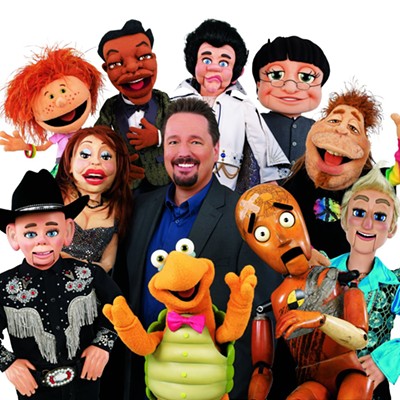Tucson author James M. Deem is a quick-witted, silver-haired writer of children's books whose work goes beyond your average hungry caterpillar or pokey little puppy.
He writes about dead bodies.
Bodies From the Ice, Bodies From the Ash and Bodies From the Bog feature bodies found in glaciers, buried in Pompeii after the eruption of Vesuvius, and mummified in swamplands, respectively. Auschwitz and Kristallnacht examine the Holocaust.
His upcoming Faces From the Past: Forgotten People of North America focuses on facial reconstructions of ancient remains discovered throughout the continent.
Although his books are riddled with death, their goal is to bring history to life. The victims have a story to tell, and Deem, 62, is a mesmerizing messenger.
Born in West Virginia, Deem lived in Tucson as a kid from 1961 to 1965; he moved here for good in 2004. He taught high school English and French in Kansas and Michigan, and moved on to the college level after obtaining his master's and doctorate degrees from the University of Michigan. He spent the final 19 years of his teaching career at the John Jay College of Criminal Justice in New York City.
Kids, as well as adults, are enamored of his works, especially when he brings his books to classrooms to offer lessons on the topics. He makes such onerous subjects work through his extensive teaching background.
He also leaves out the gore.
"I present factual descriptions," Deem says. His books are highly compatible with subjects such as archaeology and history.
"The topics can be woven into the lessons," Deem says. "We can ask how they died, what they ate before they died. Kids and teachers are so spellbound by the subjects, especially with the Holocaust. They say, 'I can't believe this happened.'"
His two Holocaust books, Auschwitz: Voices From the Death Camp and Kristallnacht: The Nazi Terror That Began the Holocaust, are closer to textbooks than his earlier works, but aren't as kid-unfriendly as the texts Deem recalls from his youth. He particularly remembers an old-school science text with mounds of print, a few tedious line drawings and the ability to make even the most fascinating science lessons as exciting as a chip of paint.
His Holocaust books relate the stories of the victims through the victims' own words. Deem did his research through letters, newspaper articles, books, museums and a visit to Auschwitz.
"I owed it to the victims to walk through Auschwitz," Deem says. "It would have been dishonest if I had not been there."
His honesty paid off, not only with a detailed look into what it was like to experience the terror of the times, but also with a letter from a survivor. Kristallnacht opens with a glimpse into the life of 12-year-old Francis Schott, whose family's apartment was stormed by Nazis on the first night of Kristallnacht. Schott wrote Deem to say he was moved by the book. He is not the only one.
"Often, when I speak about Auschwitz, some kids are moved to tears," Deem says. "I think it is important to tell the story of the Holocaust so that it has an emotional impact upon the students.
"Many of the teachers know the history quite well and are happy to have a guest speaker reinforce what they are teaching. Others who don't have a background in history are just as surprised as the students when they learn the details. I often hear, 'I didn't know that. I'm really surprised.' Then I know I've done my job."
For Deem, the research itself is often fascinating. On one of his treks, to a museum
featuring Egyptian mummies, a museum official took him to a back room to show him some truly fascinating mummies. Actually, they were mummy parts stored in various cardboard boxes. The official reached into one of them, about the size of a cake box, and pulled out an ancient mummy skull.
Although Deem declined the man's offer to hold the decapitated head next to his own as he smiled for a camera, he learned a great lesson about doing research in museums.
"Always ask, 'What's in the back room no one is supposed to know about?' There were lots of dead bodies back there. And interesting postcard collections, too."
As much as he enjoyed teaching—he retired in 2003—Deem always knew his true calling was writing. He started writing his first story in the fifth-grade, after he saw strange tracks in the snow in the woods behind his house.
"They looked like some kind of monster tracks—and I knew just what kind: Space aliens had made them after their spaceship had crash-landed in our woods," he explains on his website, jamesmdeem.com.
"I had a really weird imagination," he adds.
His earliest books were rife with ghosts and UFOs, and included both fiction and nonfiction. Titles include How to Find a Ghost, How to Make a Mummy Talk, 3 NBs of Julian Drew (NB is his abbreviation for notebook) and How to Read Your Mother's Mind.
"The older I've gotten, the more I am interested in history," Deem says. "The past is very important, and I take it as a challenge to write about historical events in a way to interest children."
It's a challenge well-met, based on the reaction he receives and the speaking gigs that keep coming. Although 62, he swears he's really only 17—and he has the enthusiasm to match.
"Doing research for nonfiction books is like hunting for treasure. It is so exciting to be searching for information or a good, true story, and suddenly find it. Eureka! That is truly fun," Deem says. "Writing fiction, on the other hand, is fun in that I get to use my imagination, big-time. It's very rewarding to just let my brain go wandering when I am working on a novel."
Although his enthusiasm plays a huge part, Deem insists the real key to his success comes from three main points that any author or would-be author can relate to: "Persistence. Luck. And I'm not dead."










